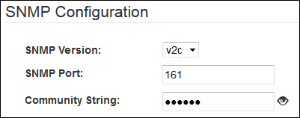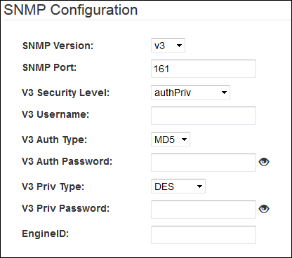SNMP Configuration
Mitel Performance Analytics supports SNMP v1, v2C, and v3 for retrieval of device information. The configuration options are different for SNMP v1 and v2C, and for SNMP v3.
The following are typical fields for SNMP v1 or v2C configuration:

SNMP v1 and v2C use a community string to authenticate SNMP requests.
Mitel Performance Analytics allows configuration of the following:
Community string (common default is “public”)
SNMP port (standard port is 161)
SNMP v3 supports a user-based security model that enables:
No authentication or encryption
Authentication only
Authentication with encryption (also referred to as Privacy)
Authentication options are MD5 and SHA.
Encryption options are DES and AES128.
NOTE: For Windows Server based devices, we recommend you use SNMP v1.
Certain SNMP v3 devices require that the SNMP agent requesting information use a specified engine ID.
The following are typical fields for SNMP v3 configuration:

Mitel Performance Analytics SNMP v3 configuration options allow you to specify:
SNMP Port (standard port is 161)
V3 Security Level: One of the following:
NoAuthNoPriv — no security, not recommended
Auth — Authentication only
AuthPriv – Authentication and encryption (Privacy), recommended
V3 Username:
V3 Auth Type: MD5 or SHA
V3 Auth Password: Required for authentication
V3 Priv Type: DES or AES128
V3 Priv Password: Required for privacy
EngineID: Leave blank in most cases; certain SNMPv3 agents may require this to be specified
SNMP v3 Trap User: Check this option if a second SNMP user is required to receive traps (i.e MiVoice 5000 devices). When selected, the following options are displayed:
V3 Trap Security Level: One of the following:
NoAuthNoPriv — no security, not recommended
Auth — Authentication only
AuthPriv – Authentication and encryption (Privacy), recommended
V3 Trap Username:
V3 Trap Auth Type: MD5 or SHA
V3 Trap Auth Password: Required for authentication
V3 Trap Priv Type: DES or AES128
V3 Trap Privacy Password: Required for privacy
Trap EngineID: Leave blank in most cases; certain SNMPv3 agents may require this to be specified